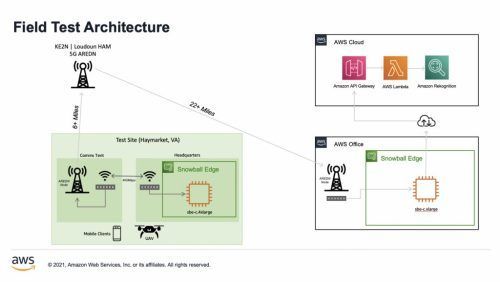Here’s’ an interesting post on the Amazon Web Services (AWS) Public Sector Blog: Amateur radio meets edge computing to keep disaster response teams connected. The post describes how the Amazon Web Services (AWS) Disaster Response team, “conducted a field testing operation designed to replicate a common disaster response scenario.”

Held in Northern Virginia, it included forward-deployed field locations (at/near the disaster site) and a headquarters location (HQ) that was more than 25 miles away. The field sites had minimal working infrastructure and no cellular or internet connectivity, and the HQ was an office building with standard internet access and stable infrastructure. The goal of the exercise was to establish an ad-hoc network at the field sites that allowed team members to collect and process data at the edge, as well as create a link between the field site and HQ using the Amateur Radio Emergency Data Network (AREDN) to provide access to cloud-based resources in the field.
It’s interesting that this test used both Amazon hardware and software. The Amazon hardware they used is the Amazon Snowball Edge, which they describe as “a data migration and edge computing device. Snowball Edge Storage Optimized devices provide 40 vCPUs of compute capacity coupled with 80 terabytes of usable block or Amazon S3-compatible object storage. It is well-suited for local storage and large-scale data transfer. Snowball Edge Compute Optimized devices provide 52 vCPUs, 42 terabytes of usable block or object storage, and an optional GPU for use cases such as advanced machine learning and full motion video analysis in disconnected environments.”
They also used Amazon Rekognition, “a machine learning (ML) service that detects and labels objects in images and video.” To use Rekognition, the test used a custom app that was hosted on the Snowball Edge at the HQ location. This app sent images to Amazon Rekognition for object detection. Users at the field site were able to upload photos from a variety of devices including mobile phones, UAV platforms, and laptops.
Of course, Amazon isn’t doing this out of the goodness of their heart. The post concludes:
AWS offers multiple programs for nonprofits to get started on the cloud, including the AWS Nonprofit Credit Program, which helps organizations offset the costs of implementing cloud-based solutions. Apply for the AWS Nonprofit Credit Program to start your journey with AWS.
I didn’t investigate how much the hardware and web services cost, so I don’t know if this makes sense for emergency communications groups with an AREDN network. I think that the idea is interesting, though, and it might be worth implementing this kind of functionality using other hardware and software. If you know of any AREDN networks that have implemented this kind of functionality, or are working on it, please let me know.
No comments:
Post a Comment